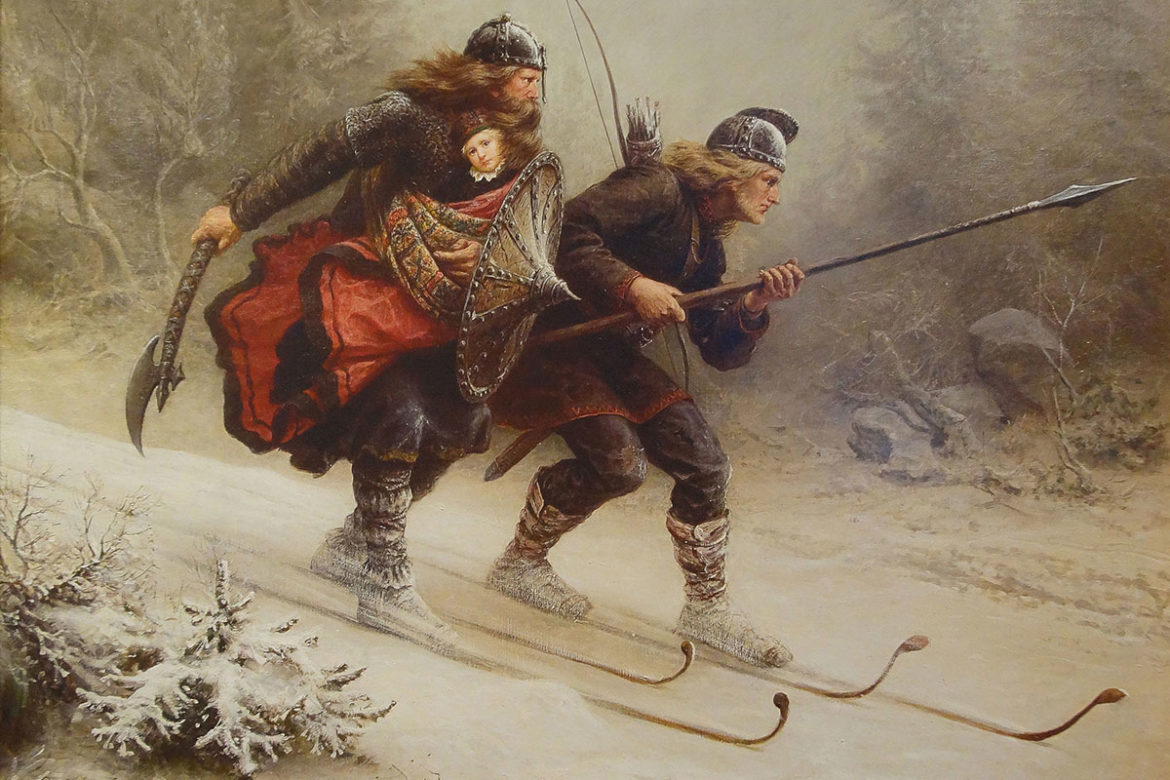45th Annual Birkebeiner – Hayward, WI Saturday February 23rd 2019
The above painting by: Knud Larsen Bergslien
From wikipedia: “Skiing Birchlegs Crossing the Mountain with the Royal Child (Norwegian: Birkebeinerne på Ski over Fjeldet med Kongsbarnet). His depiction of Birkebeiner skiers carrying Prince Haakon to safety during the winter of 1206 has become a national Norwegian icon. The prince grew up to be King Haakon IV whose reign marked the end of the period known as the Civil war era in Norway.”
LocaLeben Magazine has been granted media credentials for the 45 Annual Birkebeiner and we cannot express in words, just how excited we are. It’s my first Birkie, but I hope to chronicle the American Birkebeiner experience From the Expo and exciting events on Thursday, to the Kortelopet & Prince Haakon on Friday, to Saturday’s International race action. They say there is no greater show on snow!
Starting on Thursday, February 21, 2019 and extending through Sunday, February 24, 2019 over 13,500 skiers (all events) and an estimated 30,000 spectators will gather for North America’s largest cross-country ski marathon and Nordic festivities in and around Hayward, Wisconsin.
I’m traveling north mid week to arrive in time to get the lay of the land. My plan is to hang out – make some photographs and perhaps a little video. Watch for my coverage next week at LocaLeben.com
American Birkebeiner – A Humble Beginning
The year was 1206 and Norway was in the midst of a civil war when Birkebeiner skiers, so called for their protective birch bark leggings, skied through the treacherous mountains and rugged forests of Norway’s Osterdalen valley, smuggling Prince Haakon, the son of King Sverresson and Inga of Vartieg, to safety. The journey took the Birkebeiners and infant prince from Lillehammer to safety in the town of Trondheim. Inga of Vartieg never became queen as the prince’s father was killed before he could return for her in Vartieg. Norwegian history credits the Birkebeiner warrior’s bravery with preserving the life of the boy who later became Norway’s King Haakon Haakonsson IV and forever changed Norwegian history by his reign.
This historic moment was the inspiration for the first Birkebeiner ski race held in Norway in 1932. To this day, Norwegian skiers still carry a pack, symbolizing the weight of an 18-month child, in the Worldloppet’s Norwegian Birkebeiner Rennet race.
The American Birkebeiner began as the dream of the late Tony Wise. In 1973, and with a nod to the journey skied by the Birkebeiner warriors, thirty-four men and one lone woman gathered on the original starting line to recreate the historic adventure. Clad in woolen sweaters and knickers for the 50-kilometer race from Lumberjack Bowl in Hayward to Telemark Lodge in Cable, Wisconsin, few knew this scrappy and determined lot were about to change everything. One original founding skier, Ernie St. Germaine, has skied every American Birkebeiner race since its inception.
Each year, in homage to the race’s roots, two Birkebeiner warriors and Inga, ski the entire Birkie course on traditional wooden skis and in full period costume inspiring fellow racers along the way. The Birkebeiner warriors, with Inga, carry a baby doll along the course route and pick-up a real infant “Prince” before skiing over the American Birkebeiner International Bridge and to the finish line on Hayward’s snow-covered main street. It is a true celebration of the roots, legacy and traditions of the race.
From its humble beginnings, the American Birkebeiner has grown to become North America’s largest ski race and the third largest in the world. To date, over 250,000 skiers have finished Birkie ski events. Approximately 40,000 spectators and skiers gather each February in the Cable and Hayward, Wisconsin areas for the Nordic sports festivities and in celebration of the determination and perseverance of the Birkebeiner warriors.
You can find more info here: For a complete schedule of all 2019 Birkie week events and activities: Click Here
Full wikipedia article here: https://en.wikipedia.org/wiki/Birkebeiner


